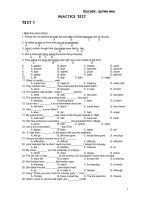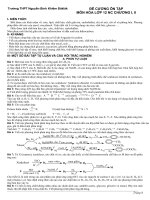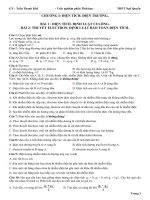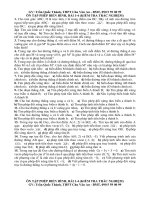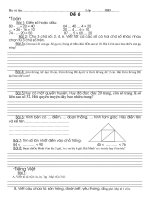Lab course on general chemistry 1 (2)
Bạn đang xem bản rút gọn của tài liệu. Xem và tải ngay bản đầy đủ của tài liệu tại đây (284.25 KB, 22 trang )
Experiment 25 Prelaboratory Assignment
Calorimetry
1. A 20.94g sample of a metal is heated to 99.4 oC in a hot water bath until thermal
equilibrium is reached. The metal sample is quickly transferred to 100.0 mL of water
at 22.0oC contained in a calorimeter. The thermal equilibrium temperature of the metal
sample plus water mixture is 24.6oC. What is the speci c heat of the metal? Express the
speci cheat with the correct number of signi can’t gures.
To find the specific heat of the metal, let's calculate the heat absorbed by the water
first:
mwater is the mass of water (100 g)
cwater is the specific heat of water (4.18 J/g·°C)
q = m × c × ΔT
qwater = 100.0 × (4.18) × (24.6 - 22.0)
qwater = 836 (J)
Since the heat released by the metal is equal in magnitude but opposite in sign to qwater:
qmetal = - qwater
qmetal = - 836 (J)
Now we can substitute the values into the equation to find the specific heat of the
metal:
c=
−q (water )
m(metal) × ΔT ¿ (metal )
c=
−(−836)
20.94 ×(24.6−99.4)
c ≈ -1.17 (J/g·°C)
2. a. Experimental Procedure, Part A.1. What is the procedure for heating a metal to an
exact but measured temperature?
Step 1: Set up a hot water bath by heating water in a container.
Step 2: Measure the initial temperature of the hot water bath.
Step 3: Weigh the metal sample to determine its mass.
Step 4: Immerse the metal sample in the hot water bath and stir gently.
Step 5: Monitor and adjust the heat source to maintain a constant temperature.
Step 6: Wait until the metal sample reaches thermal equilibrium with the hot water
bath.
Step 7: Remove the metal sample from the water bath and transfer it to a separate
container.
Step 8: Measure and record the final temperature of the metal sample using a
thermometer.
b. Experimental Procedure, Part A.1. How can bumping be avoided when heating
water in a beaker?
To avoid bumping when heating water in a beaker:
1. Use a boiling chip or boiling stone.
2. Gently stir the water while heating.
3. Choose a larger beaker to allow for more space.
4. Heat the water gradually.
5. Avoid overheating and superheating.
6. Place a heat-resistant mat or wire gauze between the beaker and the heat source.
3. Experimental Procedure, Parts A.4, 5.
a. When a metal at a higher temperature is transferred to water at a lower temperature,
heat is inevitably lost to the calorimeter (Figure 25.4). Will this unmeasured heat loss
increase or decrease the calculated value of the specific cheat of the metal? Explain.
See equation 25.5.
When a metal at a higher temperature is transferred to water at a lower
temperature, heat is indeed lost to the calorimeter. This unmeasured heat loss
will decrease the calculated value of the specific heat of the metal.
The specific heat of the metal is determined based on the heat exchanged
between the metal and the water. However, if there is heat loss to the
calorimeter or the surroundings that is not accounted for, the calculated value
of the specific heat will be lower than the actual value.
The unmeasured heat loss reduces the amount of heat that is transferred
from the metal to the water. As a result, the calculated specific heat will be
lower because it is based on a smaller amount of heat transfer. The heat loss
acts as an additional heat sink, leading to an underestimation of the metal's
specific heat.
To obtain a more accurate value, it is important to minimize heat loss
during the experimental setup. Insulating the calorimeter and ensuring
efficient thermal contact between the metal and water can help reduce
unmeasured heat loss.
b. Explain why the extrapolated temperature is used to determine the maximum
temperature of the mixture rather than the highest recorded temperature in the
experiment. See Figure 25.5
Lag time: In Figure 25.5, you can see that there is a delay between the heat
transfer and the response of the thermometer. This delay is known as lag time.
The highest recorded temperature in the experiment may not accurately
represent the true maximum temperature because it might not have reached
equilibrium. The extrapolated temperature takes into account the lag time and
provides a more accurate estimation of the maximum temperature reached by
the mixture.
Temperature equilibrium: The extrapolated temperature considers the
trend of the temperature change and estimates the temperature the mixture
would have reached if there were no lag time. It takes into account the
approaching equilibrium between the metal sample and the water. This
equilibrium temperature is a more reliable indicator of the maximum
temperature achieved by the mixture.
By using the extrapolated temperature, researchers can compensate for the
lag time and obtain a more accurate estimation of the maximum temperature
reached during the experiment, providing a better understanding of the heat
transfer and the behavior of the system.
4. Experimental Procedure, Part B. Three student chemists measured 50.0 mL of
1.00 M NaOH in separate Styrofoam coffee cup calorimeters (Part B). Brett added
50.0 mL of 1.10 M HCl to his solution of NaOH; Dale added 45.5 mL of 1.10 M
HCl (equal moles) to his NaOH solution. Lyndsay added 50.0 mL of 1.00 M HCl
to her NaOH solution. Each student recorded the temperature change and
calculated the enthalpy of neutralization.
Identify the student who observes a temperature change that will be different from
that observed by the other two chemists. Explain why and how (higher or lower)
the temperature will be different.
Based on the information provided, the student who will observe a different
temperature change compared to the other two chemists is Dale.
Dale added 45.5 mL of 1.10 M HCl to his NaOH solution, which is equal
in moles to the other students' additions. However, the volume of the acid
added by Dale is different from the volumes added by Brett and Lyndsay, who
both added 50.0 mL of acid.
Since the volumes of acid and base used in the reaction are not the same for
Dale, the resulting mixture will have a different concentration compared to the
mixtures prepared by Brett and Lyndsay. This difference in concentration will
affect the heat generated during the reaction and, consequently, the observed
temperature change.
If the concentration of the acid or base is different, the heat evolved or
absorbed during the reaction will also be different. In this case, since Dale
used a smaller volume of acid, his mixture will have a higher concentration of
acid compared to the other two students. This higher concentration of acid will
result in a more exothermic reaction, generating more heat. As a result, the
temperature change observed by Dale will be higher than that observed by
Brett and Lyndsay.
5. Experimental Procedure, Part C. Angelina observes a temperature increase when
her salt dissolves in water.
a. The lattice energy for the salt is greater than the hydration energy for the salt.
Lattice energy refers to the energy required to separate the ions of a solid
salt and convert them into isolated gaseous ions. It is an endothermic process
that requires energy input. On the other hand, hydration energy refers to the
energy released when the gaseous ions combine with water molecules to form
hydrated ions in solution. Hydration energy is an exothermic process that
releases energy.
In this case, since Angelina observes a temperature increase when the salt
dissolves in water, it suggests that the dissolution process is absorbing energy
from the surroundings. This indicates that the lattice energy, which represents
the energy required to break the ionic lattice of the salt, is greater than the
hydration energy, which represents the energy released when the salt
dissolves. The higher energy requirement for breaking the ionic lattice implies
that more energy is absorbed during the dissolution process, leading to a
temperature increase.
b. The solubility of the salt will typically increase with temperature increases.
In general, as temperature increases, the solubility of most salts tends to
increase. This is because an increase in temperature provides more thermal
energy to the solvent molecules, allowing them to move more rapidly and
collide with the solute particles more frequently and with greater energy.
These energetic collisions can overcome the intermolecular forces holding the
solute together and facilitate its dissolution.
However, it is worth noting that this relationship does not apply universally
to all salts. Some salts may exhibit different solubility behavior with
temperature changes, such as decreased solubility with temperature increases.
Therefore, it is important to consider the specific solute and solvent involved
when determining the effect of temperature on solubility.
6. A 5.00-g sample of KBr at 25.0oC dissolves in 25.0 mL of water also at 25.0 oC.
The nal equilibrium temperature of the resulting solution is 18.1oC. What is the
enthalpy of solution, ∆Hs, of KBr expressed in kilojoules per mole? See equation
25.12
m is the mass of water (25.0 mL is approximately 25.0 g)
C is the specific heat capacity of water (4.18 J/g·°C)
ΔT is the change in temperature (final temperature - initial temperature)
q = (25.0 g) × (4.18 J/g·°C) × (18.1°C - 25.0°C)
q = -585.57 J (negative sign indicates heat released)
Next, we need to calculate the number of moles of KBr. We can use the molar
mass of KBr to convert the mass of the sample to moles:
molar mass of KBr = 39.10 g/mol + 79.90 g/mol = 119.0 g/mol
n = mass / molar mass
n = 5.00 g / 119.0 g/mol
n = 0.0420 mol
Now we can substitute the values into the equation to find the enthalpy of
solution:
ΔHs = q / n
ΔHs = (-585.57 J) / (0.0420 mol)
ΔHs ≈ -1.39 × 10^4 J/mol
Finally, we can convert the enthalpy of solution from joules to kilojoules by
dividing by 1000:
ΔH ≈ -1.39 × 10^4 J/mol / 1000
ΔH ≈ -13.9 kJ/mol
Therefore, the enthalpy of solution (ΔH) of KBr is approximately -13.9
kJ/mol.
Experiment 25 Report Sheet
Calorimetry
Laboratory Questions
1. Part A.1. The 200mm test tube also contained some water (besides the metal)
that was subsequently added to thecalorimeter (in Part A.4). Considering a higher
speci c heat for water, will the temperature change in the calorimeter be higher,
lower, or unaffected by this technique error? Explain.
If the 200mm test tube contained water in addition to the metal, and some of
that water was subsequently added to the calorimeter, the temperature change
in the calorimeter would be higher. This is because water has a higher specific
heat capacity compared to the metal, meaning it can absorb and retain more
heat energy. The presence of water increases the overall heat capacity of the
system, requiring more heat energy to produce a given temperature change in
the calorimeter.
2. Part A.4. When a student chemist transferred the metal to the calorimeter, some
water splashed out of the calorimeter. Will this technique error result in the
specific heat of the metal being reported as too high or too low? Explain.
The technique error of water splashing out of the calorimeter during the
transfer of the metal would result in the specific heat of the metal being
reported as too high. This is because the decreased mass of the system would
lead to a higher calculated specific heat capacity, as the heat energy is
distributed over a smaller mass, resulting in a larger temperature change for
the same amount of heat transferred.
3. Part B. The enthalpy of neutralization for all strong acid–strong base reactions
should be the same within experimental error. Explain. Will that also be the case
for all weak acid–strong base reactions? Explain.
In Part B, the statement is made that the enthalpy of neutralization for all
strong acid-strong base reactions should be the same within experimental
error. This statement is generally true for strong acid-strong base reactions due
to the nature of these compounds.
Strong acids completely dissociate in water, releasing a high concentration
of hydrogen ions (H+) into the solution. Similarly, strong bases completely
dissociate in water, producing a high concentration of hydroxide ions (OH-).
When a strong acid reacts with a strong base, the hydrogen ions from the acid
combine with the hydroxide ions from the base to form water. This is known
as a neutralization reaction.
The enthalpy of neutralization is the heat released or absorbed during a
neutralization reaction. In the case of strong acid-strong base reactions, the
formation of water is highly exothermic, meaning it releases a significant
amount of heat. Since strong acids and strong bases completely dissociate, the
reaction proceeds to completion, resulting in the same number of moles of
water formed per mole of acid and base reacted.
As a result, the enthalpy of neutralization for strong acid-strong base
reactions tends to be consistent within experimental error. However, it's
important to note that some variations in experimental conditions or specific
acid-base combinations may introduce minor deviations, but these are usually
within an acceptable range.
On the other hand, for weak acid-strong base reactions, the enthalpy of
neutralization may not be the same as for strong acid-strong base reactions.
Weak acids do not fully ionize in water, meaning that not all acid molecules
donate hydrogen ions. Consequently, the neutralization reaction with a strong
base may not proceed to completion, and some of the acid may remain
unreacted. This incomplete reaction can result in a different enthalpy of
neutralization compared to strong acid-strong base reactions.
In summary, while the enthalpy of neutralization is generally consistent for
strong acid-strong base reactions, it may vary for weak acid-strong base
reactions due to incomplete dissociation of weak acids.
4. Part B. Heat is lost to the Styrofoam calorimeter. Assuming a 6.22 oC
temperature change for the reaction of HCl(aq) with NaOH(aq), calculate the heat
loss to the inner 2.35-g Styrofoam cup. The specific heat of Styrofoam is 1.34
J/g•oC.
Q is the heat energy (in joules),
m is the mass of the Styrofoam cup (in grams),
c is the specific heat capacity of Styrofoam (in J/g°C),
ΔT is the temperature change (in °C).
Given:
m = 2.35 g
c = 1.34 J/g°C
ΔT = 6.22°C
Plugging in the values, we have:
Q = mcΔT
Q = (2.35 g) × (1.34 J/g°C) × (6.22°C)
Q ≈ 19.95 (J)
Therefore, the heat loss to the inner Styrofoam cup is approximately 19.95
Joules.
5. Part B.3. Jacob carelessly added only 40.0 mL (instead of the recommended
50.0 mL) of 1.1 M HCl to the 50.0 mL of 1.0 M NaOH. Explain the consequence
of the error.
By adding only 40.0 mL of 1.1 M HCl instead of the recommended 50.0
mL to the 50.0 mL of 1.0 M NaOH, Jacob has deviated from the balanced
stoichiometry of the neutralization reaction. The consequence of this error is
that there will be an excess of NaOH remaining in the solution after the
reaction is complete. This means that not all of the HCl will react with the
NaOH, leading to an incomplete neutralization. The resulting solution will be
basic because there is excess base (NaOH) present.
6. Part B.3. The chemist used a thermometer that was miscalibrated by 2 oC over
the entire thermometer scale. Will this factory error cause the reported energy of
neutralization, ∆Hn, to be higher, lower, or unaffected? Explain.
The miscalibration of the thermometer by 2°C over the entire scale will
cause the reported energy of neutralization (ΔHn) to be unaffected. The reason
is that the miscalibration affects the absolute temperature measurement, but
the change in temperature (ΔT) is what matters for the calculation of ΔHn.
Since ΔT is the difference between the initial and final temperatures, the
miscalibration of the thermometer will have the same effect on both the initial
and final temperatures, canceling out in the calculation of ΔT. Therefore, the
miscalibrated thermometer will not impact the reported energy of
neutralization.
7. Part C.3. If some of the salt remains adhered to the weighing paper (and
therefore is not transferred to the calorimeter), will the enthalpy of solution for the
salt be reported too high or too low? Explain.
If some of the salt remains adhered to the weighing paper and is not
transferred to the calorimeter during the measurement of the enthalpy of
solution, the enthalpy of solution for the salt will be reported as too low. This
is because the weighing paper acts as an insulator, preventing heat transfer
between the salt and the calorimeter. As a result, the heat released or absorbed
during the dissolution of the salt will not be fully captured and measured in
the calorimeter, leading to an underestimated enthalpy of solution.
8. Part C. The dissolution of ammonium nitrate, NH 4NO3, in water is an
endothermic process. Since the calorimeter is not a perfect insulator, will the
enthalpy of solution, ∆Hs, for ammonium nitrate be reported as too high or too
low if this heat change is ignored? Explain.
The dissolution of ammonium nitrate (NH4NO3) in water is an endothermic
process, meaning it absorbs heat from the surroundings. If this heat change is
ignored due to the calorimeter not being a perfect insulator, the enthalpy of
solution (ΔHs) for ammonium nitrate will be reported as too low. This is
because the heat absorbed during the dissolution process is lost to the
surroundings through the imperfect insulation of the calorimeter. As a result,
the measured heat change will be lower than the actual value, leading to an
underestimated enthalpy of solution.
Experiment 12 Prelaboratory Assignment
Molar Mass of a Volatile Liquid
1. The following data were recorded in determining the molar mass of a volatitle
liquid following the Experimental Procedure for this experiment.
Mass of dry ask, foil, and rubber band (g)
74.722 g
Temperature of boiling water (oC, K)
98.7 ° C
Mass of dry ask, foil, rubber band, and vapor (g)
74.921 g
Volume of 125-mL ask (L)
0.152 L
Atmospheric pressure (torr, atm)
752 torr / 0.989 atm
a. How many moles of vapor are present?
n( vapor )=
0.989 atm ×0.125 L
≈ 0. 0 04927(mol)
atm
0.08206 ∙
×37 1.85 K
mol
b. What is the molar mass of the vapor?
M ( compound )=
0.199 g
=40.39 ¿)
0.004927 mol
2. a. If the atmospheric pressure of the ask is assumed to be 760 torr in question 1,
what is the reported molar mass of the vapor?
Moles of Vapor=
Molar Mass=
1 atm ×0.152 L
≈ 0.004981(moles)
atm
0.08206 L∙
× 371.85 K
mol
mass of vapor
0.199 g
=
=39.95(g /mol)
moles of vapor 0.004981 moles
b. What is the percent error caused by the error in the recording of the pressure of
the vapor?
% error=
M difference
× 100
Mactual
40.39 g/mol−39. 95 g /mol
¿
× 100=1.09 %
40.39 g /mol
3. The ideal gas law equation (equation 12.1) is an equation used for analyzing ideal
gases. According to the kinetic molecular theory that de nes an ideal gas, no ideal
gases exist in nature, only real gases. Van der Waals’ equation is an attempt to
make corrections to real gases that do not exhibit ideal behavior. Describe the type
of gaseous molecules that are most susceptible to nonideal behavior.
The deviations from ideal behavior are more pronounced in gases that have:
High pressure: At high pressures, the volume occupied by gas molecules
becomes significant compared to the total volume of the gas. This leads to
intermolecular interactions, such as attractive forces between molecules,
becoming more significant and causing deviations from ideal behavior.
Low temperature: At low temperatures, the kinetic energy of gas molecules
decreases, reducing the tendency to overcome intermolecular forces. As a
result, molecules are more likely to interact with each other, leading to
deviations from ideal behavior.
Large molecular size: Gases composed of molecules with large sizes have a
greater likelihood of experiencing intermolecular interactions. These
interactions can result in deviations from ideal behavior due to increased
molecular volume and potential attractive forces between molecules.
Polar molecules: Gases composed of polar molecules have an uneven
distribution of electron density, leading to dipole-dipole interactions between
molecules. These intermolecular forces can cause nonideal behavior,
particularly at high pressures and low temperatures.
These factors contribute to deviations from ideal behavior and require
corrections in the ideal gas law. Van der Waals' equation is one such attempt
to account for these deviations by introducing correction terms for molecular
size and intermolecular forces, providing a more accurate description of the
behavior of real gases.
4. a. How is the pressure of the vaporized liquid determined in this experiment?
A barometer is used.
b. How is the volume of the vaporized liquid determined in this experiment?
Filling a 125 mL Erlenmeyer flask with water, volume is measured by
transferring water to a graduated a cylinder.
c. How is the temperature of the vaporized liquid determined in this experiment?
After the water reaches a gentle boil the temperature is recorded with a
thermometer.
d. How is the mass of the vaporized liquid determined in this experiment?
Allow the gas to cool to room temperature then dry the outside of the flask
a measure with a balance.
5. The molar mass of a compound is measured to be 30.7, 29.6, 31.1, and 32.0 g/mol
in four trials.
a. What is the average molar mass of the compound?
To calculate the average molar mass of the compound, you need to sum up
the measured values and divide by the number of trials. Let's do the
calculation:
Average molar mass = (30.7 + 29.6 + 31.1 + 32.0) / 4 = 123.4 / 4 = 30.85
(g/mol).
Therefore, the average molar mass of the compound is 30.85 (g/mol).
b. Calculate the standard deviation and the relative standard deviation (as %RSD)
(see Appendix B) for the determination of the molar mass.
The deviation of each measurement from the mean
Square each deviation
Deviation1 = 30.7 - 30.85 = -0.15 (g/mol)
0.0225 (g2/mol2)
Deviation2 = 29.6 - 30.85 = -1.25 (g/mol)
1.5625 (g2/mol2)
Deviation3 = 31.1 - 30.85 = 0.25 (g/mol)
0.0625 (g2/mol2)
Deviation4 = 32.0 - 30.85 = 1.15 (g/mol)
1.3225 (g2/mol2)
Sum of squared deviations = 0.0225 + 1.5625 + 0.0625 + 1.3225 = 1.97 (g2/mol2)
Calculate the variance by dividing the sum of squared deviations by (n-1),
where n is the number of measurements:
Variance = 1.97 / (4-1) = 0.6567 (g2/mol2)
Take the square root of the variance to find the standard deviation:
Standard deviation = √ 0.6567 = 0.8101 (g/mol)
Calculate the relative standard deviation (%RSD) by dividing the standard
deviation by the mean and multiplying by 100:
%RSD = (0.8101 / 30.85) * 100 = 2.63%
Experiment 12 Report Sheet
Trial 1
Trial 2
Trial 3
A. Preparing the Sample
1. Mass of dry ask, foil, and rubber band
(g)
85.2672
B. Vaporize the Sample
1. Temperature of boiling water (° C, K)
368.15 K
367.65 K
368.74 K
2. Mass of dry ask, foil, rubber band, and
vapor (g)
85.8673
86.1092
86.1258
C. Determine the Volume and Pressure
of the Vapor
1. Volume of 125-mL ask (L)
0.144
0.08 L + 0.02 L + 0.014 = total volume
2. Atmospheric pressure (torr, atm)
0.997 atm
D. Calculations
1. Moles of vapor, nvapor (mol)
4.80E-03
4.80E-03
4.80E-03
2. Mass of vapor, mvapor (g)
6.00E-01
8.42E-01
7.36E-01
3. Molar mass of compound (g/mol)
125.0208*
175.4167
154.6391
4. Average molar mass (g/mol)
150.2188
5. Standard deviation of molar mass
35.635
Appemdix B
6. Relative standard deviation of
molecular mass (%RSD)
23.72
Appemdix B
Molar Mass of a Volatile Liquid
E. Calculations (van der Waals’ equation)
Trial 1*
Trial 2
Trial 3
1. Moles of vapor, nvapor (mol)
0.0048
0.0048
0.0047
2. Mass of vapor, mvapor (g)
0.6001
0.8420
0.8586
125.0208
175.4167
182.6809
3. Molar mass of compound (g/mol)
4. Average molar mass (g/mol)
161.0395
Laboratory Questions
1. Part A.1. The mass of the ask (before the sample in placed into the ask) is measured
when the outside of the ask is wet. However, in Part B.3, the outside of the ask is
dried before its mass is measured.
a. Will the mass of vapor in the ask be reported as too high or too low, or will it be
unaffected? Explain.
The mass of vapor in the ask will be reported as too high if the outside of
the ask is wet during the measurement. When the outside of the ask is wet, it
includes the mass of the water or moisture present on the surface. Therefore,
when the mass of the ask is measured, it will include the mass of the water vapor,
leading to an overestimation of the vapor mass.
b. Will the molar mass of vapor in the ask be reported as too high or too low, or
will it be unaffected? Explain.
The molar mass of the vapor in the ask will be unaffected by whether the
outside of the ask is wet or dry during the measurement. The molar mass is a
property of the gas and is independent of any external conditions. Therefore,
even if the mass of the vapor is overestimated due to the wet surface of the ask,
the molar mass will remain the same. It is determined by the composition of the
vapor and the molar masses of its constituent elements or compounds, and it does
not change with variations in the measurement procedure or the presence of
moisture on the outside surface of the ask.

